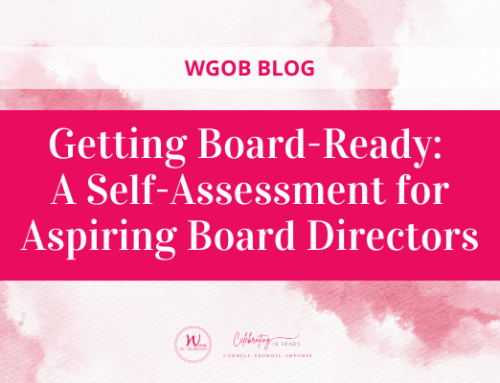Across all sectors, there has been a wave of adoption of advisory boards. Not only do advisory boards provide business leaders with support to navigate growth cycles and make sound decisions, but they help companies adapt to changing compliance requirements and stakeholder expectations.
Recognizing their value, organizations must consider how they can best implement and facilitate their advisory board to leverage it effectively.
To foster discussion around this emerging topic, Women Get On Board Inc. (WGOB) hosted a virtual conversation on August 22, sponsored by Advisory Board Centre, as part of the WGOB Speaker Series.
Dr. Deborah Rosati, FCPA, FCA, ICD.D, GCB.D, CCB.D, Corporate Director and WGOB Founder and CEO, kicked off the conversation by introducing Louise Broekman, Founder of Advisory Board Centre. In addition to founding the professional body for the advisory board sector, Louise is an award-winning entrepreneur, researcher, and business advisor, with industry and government recognition for her contributions to the business sector.
Louise began her remarks by introducing the State of the Market report, which the Advisory Board Centre produced to outline what’s happening in the advisory board sector right now and where it’s heading the future. Then, she explored key trends that board members should be aware of as these bodies continue to become more ubiquitous across the business landscape.
The Emergence of Governance Systems
Louise explained that one of the key evolutions happening right now in the corporate world is the movement away from the traditional view of advisory boards towards more integrated governance systems. In the traditional view, the advisory board and the governance board are separate, with the advisory board focused solely on problem solving and the governance board focused on decision making.
“In the past, we used to talk about them as being very separate functions,” said Louise. “Today, they’re working side by side, one working in conjunction with the other.”
With that shift in mind, professionals in the sector have moved away from discussing governance boards in isolation. Instead, they think about governance systems. Louise noted that while some governance boards are shrinking, the wider systems they’re apart of are growing, on average.
Today’s governance dilemma? Board directors are faced with a bigger agenda than ever before, but they still face the same constraints that they always have, including personal liability. Agendas are ballooning at the boardroom table and decisions are getting more complex.
Advisory boards are one solution to this dilemma, because they contribute key expertise and problem-solving functions to the governance system. Other solutions to address the increasng board agenda might include more directors or committees, longer hours and more board meetings, or bringing in consultants and specialist employees to fill the gaps.
The Growing Stakeholder Economy
Another megatrend to watch is the growth of the stakeholder economy. As new regulations roll out requiring quality stakeholder engagement, it’s becoming more complex to manage the various interests.
“The market is demanding directors to make different decisions,” said Louise. “So how do they do that in a way that actually engages stakeholders but also makes it safe for the directors who have to make those decisions?”
Specialized advisory boards can play a role in that engagement, such as customer and thought leadership advisory boards that are created to provide a voice to specific groups. Louise pointed out that such bodies can amplify the voices of vulnerable customers, such as advisory boards in the aged care sector in her home country of Australia.
The State of the Advisory Board Sector
Growth in the advisory board sector has exploded in recent years, with the amount of active advisors rising from 1.3 million globally in 2019 to 2.6 million in 2023.
“It’s really great to see the increase of individuals choosing advisory boards as a profession. But it’s also problematic,” said Louise.
She noted that the Advisory Board Centre is currently the only professional body in the world for advisory boards. When people enter the space who don’t know what they’re doing, it can create substantial harm. Still, this development is also an incredible opportunity for new leaders to shine in the advisory space, especially women.
The Advisory Landscape
The advisor engagement model can vary greatly, spanning from the most informal advisory relationships with family and friends or business peers, to the most formal advisors and boards with established frameworks and roles. In the middle of the spectrum lies professionals such as business coaches, consultants and accountants, as well as network groups like Women Get On Board.
Formal advisory boards generally follow a charter with a clear and defined purpose, and include an independent chair, external advisors and internal representatives. They’ll generally meet four times per year and measure impact annually, at minimum.
“Advisory Boards are not all equal either,” explained Louise. “There are so many different variations.”
They can range from informal bodies, on demand advisor panels and peer advisory boards to more formal entities such as advisory boards of one, pop-up advisory boards, project advisory boards, and best practice advisory boards.
Market Trends for Advisory Boards
The Advisory Board Centre groups current market trends into a handful of categories.
Emerging: These are companies that are pre-revenue to up to $1.5 million. They make up 29% of advisory board appointments and have a 45% volatility rate, meaning that the models they use for their boards tend to shift.
Business: These are companies that generate $1.5 to $100 million in revenue, and they tend to be the most likely to launch an advisory board. The average size of a business with an advisory board sits around $20 million.
Corporatized: These are companies already equipped with a well-structured governance board that are forming an advisory board to inform strategy, particularly around specialized topics such as sustainability, transformation, customer, cybersecurity, diversity and inclusion, mergers and acquisitions, or entering international markets.
Projects with Purpose: Project advisory boards make up 53% of newly created advisory boards. Companies of all sizes, including giants such as Google, utilize this type of board to execute short projects lasting three to 18 months. It’s an innovative, agile approach to leveraging the power of advisory boards.
Louise also highlighted long term trends in the sector. She noted the various roles that are now encompassed in the advisory board profession, including the advisory board professional, the portfolio professional, the transition professional, and the internal chair and advisory board manager.
The most critical trend? The growing focus on best practices and ethics in this emerging field. The Advisory Board Centre has just released the third edition of its Advisory Board Best Practice Framework. The framework includes five key principles:
- Structure & Discipline: Ensuring simplicity and rigor
- Clarity of Scope: What the board is there to do
- Independence: A critical element of any successful advisory board
- Measurement: Tracking impact
- Fit for Purpose: The purpose should determine what voices are brought in around the table
The bottom line
Advisory boards are a sector experiencing rapid growth—and with good reason. They provide a range of advantages for companies of all sizes, including problem-solving acumen, agile, project-based support, subject matter expertise, and a solution to the ballooning governance board agenda that boards in every industry are struggling to address. As advisory boards grow in importance, adopting best practices and integrating them into a dynamic governance system will be critical for their successful adoption.
Don’t miss our next WGOB Speaker Series event on November 25, which explores the Emerging Trends for Audit Committees in 2025. An expert panel will address topics that are trending now and what you need to know or be aware of as you look ahead to fulfilling your role as an audit committee chair or member in 2025. Click here to register now.






